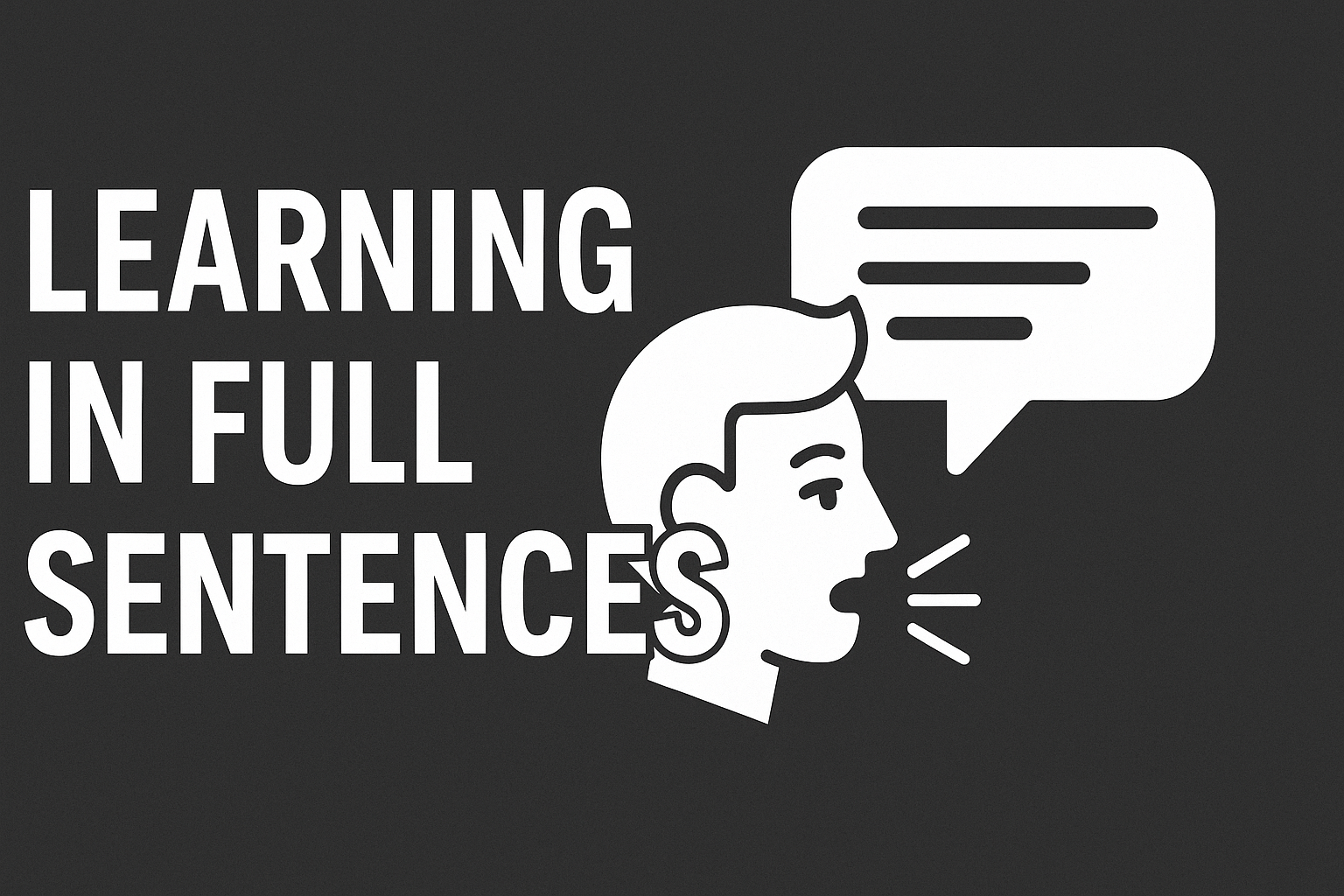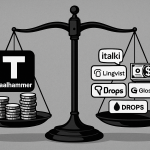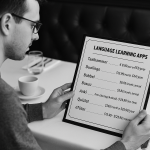Most language learning apps promise fast results. Some make it feel like a game. Others load you with flashcards or grammar tips. But very few of them teach you how to speak the way people actually speak — in real, complete sentences.
Memorizing vocabulary is easy. Clicking your way through multiple choice questions is even easier. But if your goal is to have conversations, express ideas, or understand natural speech, you’ll need more than isolated words. You’ll need to start thinking in full sentences — and that means learning differently.
A good language learning app should not just drill words. It should help you understand, recall, and produce entire sentences. That’s where real fluency begins. In this article, we compare twelve of the most popular language learning apps to see which ones actually help you speak in full, natural sentences — and which ones just give you the illusion of progress.
- How We Compared the Language Learning Apps
- Taalhammer vs Duolingo: Real Sentences or Gamified Fragments?
- Taalhammer vs Babbel: Structured Grammar or Contextual Fluency?
- Taalhammer vs Busuu: Personalized Learning or Peer Corrections?
- Taalhammer vs Anki & Quizlet: Flashcards or Full Communication?
- Taalhammer vs Lingvist & LingQ: AI-Powered Sentences or Just More Reading?
- Taalhammer vs Glossika & eTutor: Sentence Drills or Real Expression?
- Taalhammer vs italki: Human Tutors or AI Sentence Mastery?
- Taalhammer vs Memrise: Smart Repetition or Sentence-Level Fluency?
- What to Look for in a Language Learning App That Teaches Sentences
- The Final Verdict: Why Taalhammer Leads in Sentence-Based Learning
- FAQs
- Can I really learn to speak in full sentences using an app?
- Which language learning app teaches full sentences, not just words?
- What’s better: repeating full sentences or learning grammar rules?
- Is speaking practice possible without a live tutor?
- How do I know if an app will actually help me speak fluently?
How We Compared the Language Learning Apps
We focused on how each app handles full sentences — not just whether they show them, but whether they help you actually speak and understand them. We looked at four core areas:
- Input: Are you exposed to full, meaningful sentences with natural audio?
- Output: Does the app let you write, speak, or build your own sentences?
- Feedback: Are you corrected or guided when you make mistakes?
- Control: Can you personalize what you learn or create your own content?
The goal wasn’t just to rank language learning apps. It was to understand what kind of learning experience each one offers — and whether that experience helps you move from memorizing to communicating.
Taalhammer vs Duolingo: Real Sentences or Gamified Fragments?
How each langueg learning app introduces and repeats sentence content
Taalhammer is built entirely around full sentences. First you learn the ingredients: words and phrases, and later you put them all together to create a full sentence. Every unit, review, and repetition is based on a meaningful phrase. You don’t just learn “dog” or “run”; you those words and later: “to run after”, “to be excited” and finally “The dog runs after the ball because it’s excited.” These sentences are chosen or created based on your level and interests, and the app uses spaced repetition to make sure you don’t forget them.
Duolingo, by contrast, mixes full sentences with fragments in a different way. At early levels, most content is focused on sentence building through tapping tiles. Sentences are often short and simplified. While you do see full phrases eventually, they’re not always natural-sounding, and the repetition focuses more on vocabulary than structure.
Speaking and writing: does it go beyond tapping tiles?
Taalhammer asks you to recall or reconstruct full sentences. That means you’re actively writing or saying full thoughts, not just picking the right word from a list. You also get to create your own sentences and add them to your learning cycle – which reinforces both grammar and memory.
Duolingo, while accessible and fun, relies heavily on tapping. Its speaking and writing components are limited in terms of feedback. You rarely write freely, and there’s no way to add your own content or practice with your own phrases. Some Duolingo users complain about the lack of this option.
Do you want to know which of those two apps fits better your learning style? I analysed both of them it this artile: Taalhammer vs. Duolingo: Which Language App Is Actually Better for Learning and for Whom? Read it if you’re considering using one of those language learning apps but want to make an informed decision.
Which language learning apps better support sentence-level thinking?
If you want to move from “learning words” to actually thinking in a new language, Taalhammer is the stronger option. It helps you internalize full sentence patterns and trains both comprehension and recall. Duolingo is better for casual learners or those looking to build a habit — but for real sentence-based fluency, it doesn’t go deep enough.
Taalhammer vs Babbel: Structured Grammar or Contextual Fluency?
Do the lessons teach you to produce full sentences or just recognize patterns?
Babbel follows a more traditional, curriculum-based approach. Its lessons are organized around grammar topics and practical themes like “ordering food” or “introducing yourself.” You’re often asked to fill in blanks within sentences or choose the correct form of a verb. While this helps you recognize sentence structure, the focus is more on form than on free production. You’re guided toward correct answers, but not always encouraged to create your own.
Taalhammer takes the opposite approach. It doesn’t teach grammar rules in isolation. Instead, it embeds grammar inside real, high-frequency sentences. You don’t study the past tense through tables — you learn it by seeing and using sentences like “I didn’t have time yesterday because I was working.” The structure becomes familiar through repetition and context, not through explanation.
How natural is the content?
In Babbel, sentence examples are generally clear and useful, but sometimes feel a bit textbook-like. While the app has made efforts to improve realism in its dialogues, the language can be overly formal or simplified to match grammar targets. That makes it easy to follow but not always how people speak in real life.
Taalhammer focuses on natural, spoken-style sentences from the very beginning. Whether you’re learning casual conversation or more formal phrases, the sentences reflect everyday speech — full of idioms, fillers, and patterns you’d actually hear. Because the content is AI-curated and constantly updated, it evolves with user behavior and trends, avoiding the stiffness often found in pre-written lessons.
Which language learning app helps you internalize grammar through real use?
Babbel does a good job at showing how grammar works. But Taalhammer goes further by letting you experience it. Instead of explaining conjugations or rule sets, it gives you repeated exposure to correct usage in full context — which means your brain starts to absorb grammar implicitly. That’s a powerful way to learn, especially for adults who want to focus on fluency, not memorization.
If you’re thinking about learning a Romance language like Italian, French, or Spanish, be sure to check out this article comparing two top apps: Taalhammer vs. Babbel – Which App Is Best for Learning French, Italian, Spanish, and Other Romance Languages in 2025?
Taalhammer vs Busuu: Personalized Learning or Peer Corrections?
Are you speaking real sentences or checking boxes?
Busuu offers a mix of dialogues, fill-in-the-blank exercises, and short writing prompts. One of its key features is peer correction: when you complete a writing or speaking task, another user (usually a native speaker) can review it and give you feedback. While this can be helpful, the quality of corrections varies. And the exercises themselves often lean toward completion tasks, not full expression.
Taalhammer is more focused on active sentence production. It encourages users to write, speak, and recall full sentences based on realistic scenarios. You’re not just filling gaps or rearranging words — you’re producing language. Plus, the app tracks how well you remember each sentence and reintroduces it using spaced repetition, which reinforces both structure and content.
Who controls what you learn and how?
Here’s a quick comparison:
| Feature | Taalhammer | Busuu |
|---|---|---|
| Control over content | Full (user-generated sentences) | Limited to pre-made courses |
| Sentence repetition system | AI-driven, spaced repetition | Review manager, less flexible |
| Peer interaction | None (AI only) | Available for feedback |
| Speaking/writing practice | Structured and personalized | Present, but less guided |
With Busuu, your path is largely fixed: lessons are arranged by CEFR levels, and you follow a progression defined by the platform. While this creates structure, it can feel rigid if your goals don’t match the course layout.
Taalhammer, on the other hand, gives you control over what you study. You can create or import sentence content based on your own life, job, or travel plans — and the app adapts to your memory patterns automatically.
Which language learning app gives you better feedback on full-sentence production?
Busuu’s peer feedback is human, but inconsistent. It can be encouraging, especially for social learners, but it’s not guaranteed to be accurate or timely. In contrast, Taalhammer offers instant, AI-generated feedback on sentence production. Whether you’re typing or speaking, the system checks your structure, vocabulary, and grammar in real time. This makes the feedback faster, more consistent, and available any time you study — not just when another user is online.
Taalhammer vs Anki & Quizlet: Flashcards or Full Communication?
Can spaced repetition help you learn whole sentences?
Both Anki and Quizlet are flashcard platforms. They use spaced repetition to help learners memorize information over time. But the key difference lies in what you’re reviewing. Most public decks on both platforms are built around individual words, translations, or grammar rules — not complete, natural sentences.
Taalhammer also uses spaced repetition, but its algorithm is built for sentence-level learning. Every repetition is based on meaningful phrases, not flashcards. The idea isn’t just to remember a word like “because” — it’s to learn how “because” works inside a sentence like “I stayed home because it was raining.”
How much work does the user need to do to make these apps work for real fluency?
Here’s the main issue with Anki and Quizlet: they can be powerful tools, but they rely entirely on the user to create effective content. If you don’t manually build or import sentence decks, the default experience will teach you isolated words — not usable language.
Taalhammer solves that problem by:
- Providing curated sentence content at every level
- Allowing users to create or import their own sentences
- Automatically repeating those sentences based on memory tracking
- Focusing on real communication patterns, not vocabulary drills
In short, it’s the difference between tool and system. Anki and Quizlet are flexible, but require effort and knowledge to make them work well for sentence learning. Taalhammer works out of the box — and keeps improving as you use it.
Want to know which app uses science-backed techniques to boost fluency?
⮕Taalhammer vs. Quizlet: Which Language Learning App Is Truly Science-Based?
Which one gets you to sentence-level faster?
If you’re a language nerd who enjoys building your own flashcards, Anki or Quizlet can be highly effective — especially if you use sentence-based decks. But for most learners, especially beginners and busy adults, Taalhammer offers a smoother, more targeted path to speaking and understanding full sentences. You don’t need to design the system yourself. It’s already built to teach you how people actually talk.
Taalhammer vs Lingvist & LingQ: AI-Powered Sentences or Just More Reading?
How does each app handle full sentences?
Lingvist uses full sentences mainly as context for vocabulary practice. You often complete short sentence fragments by filling in a missing word. The sentence is there, but you’re focused on vocabulary — not on building or speaking full thoughts.
LingQ gives you long-form, real-world content: podcasts, news articles, stories. You read or listen to entire sentences, often with transcripts and clickable words. But you’re never really asked to produce anything. It’s input-heavy and learner-led. You can read more about how to use this app as a beginner when you click on the link.
Taalhammer flips this model. It starts by training you to recall and produce entire sentences. The app uses memory-based algorithms to test and repeat full phrases you’ve learned — whether you’re speaking, writing, or listening. You engage with language the way you use it in real life.
Which one helps you use full sentences — not just recognize them?
Here’s how they compare:
Taalhammer
- Produces full sentences from day one
- Offers feedback on writing and speaking
- Remembers what you struggle with and adapts
- Encourages you to create, not just observe
Lingvist
- Helps with pattern recognition
- Good for grammar + vocabulary reinforcement
- Less focused on full-sentence recall
- Output is limited to fill-in-the-gap tasks
LingQ
- Best for immersion and volume of input
- Ideal for intermediate learners who love reading
- No structured speaking or writing practice
- Sentence production is completely up to you
If your goal is active fluency…
Taalhammer is the clear choice. It bridges the gap between passive exposure and active recall. You don’t just read or listen — you’re building memory and confidence by using real sentences, repeatedly.
Lingvist and LingQ are valuable as supplementary tools, especially for learners who already have a foundation and want more content. But for sentence-based speaking and retention, they don’t guide you far enough.
Taalhammer vs Glossika & eTutor: Sentence Drills or Real Expression?
Are you being trained to repeat — or to express yourself?
Glossika is built around choral sentence repetition. You listen to a sentence in your target language, then repeat it aloud — again and again. The idea is to absorb grammar and pronunciation through exposure and muscle memory. But while the method is effective for reinforcing patterns, it’s mostly passive. You’re not asked to create anything new or adapt the sentence to your own life.
eTutor is a language learning app that follows a more academic route. It teaches grammar, vocabulary, and reading skills through structured lessons. Sentences are part of the experience, but they’re usually tied to specific grammar explanations. You learn to recognize sentence forms and translate them, but there’s little freedom to explore or personalize what you’re learning. Also a short desclaimer, it’s a Polish app so it’s mostly for the Poles wanting to learn other languages.
Taalhammer shifts the focus to spontaneous expression. You’re not just repeating after a voice or completing exercises — you’re building, recalling, and producing full sentences that match your goals and interests. Whether you’re preparing for travel, work, or everyday life, the app helps you learn exactly the phrases you need — and then remember them through targeted repetition.
Which language learning app gives you more control over sentence complexity and relevance?
Taalhammer
- Lets you import or create your own sentences
- Adapts difficulty based on your progress
- Uses AI to determine when and how to repeat each sentence
- Encourages speaking and writing in your own voice
Glossika
- Offers thousands of prewritten sentences
- Repetition builds rhythm and accent
- No content personalization — same sentences for everyone
- Works best as a listening/pronunciation tool
eTutor
- Follows CEFR-based curriculum
- Focuses on grammar through sentence examples
- No user-generated input or flexible structure
- Useful for school settings, less so for real-life fluency
Which one leads to actual language use?
If your goal is to train your ear and improve pronunciation without much interaction, Glossika is a solid choice. eTutor is helpful for learners who want a clear syllabus and a school-like environment.
But if you want to actually speak in full sentences, in your own words, Taalhammer offers the most control, flexibility, and depth. It doesn’t just teach you how sentences sound — it teaches you how to make them your own.

Taalhammer vs italki: Human Tutors or AI Sentence Mastery?
Live lessons or sentence-based self-study?
italki connects learners with professional tutors and community teachers for live one-on-one lessons. You speak in real time, ask questions, and get immediate correction. If you’re comfortable talking to strangers and can afford consistent sessions, italki can be very effective. You get exposed to full sentences in natural conversations, and over time, you learn to build them yourself — assuming your tutor pushes you to do that.
Taalhammer takes a self-guided approach — but it doesn’t mean passive. Instead of live interaction, it uses AI to create a structured environment where you’re repeatedly prompted to recall and produce full sentences. The system tracks what you forget, what you hesitate on, and what you’ve mastered — and adjusts the timing and content of reviews accordingly. It’s consistent, flexible, and focused on memory.
How do the experiences compare for speaking practice?
italki
- Live conversation with native speakers
- Immediate correction during speaking
- Highly variable experience depending on the tutor
- No consistent review system — it’s up to you to retain what you learn
Taalhammer
- Structured sentence production (typing and speaking)
- Instant AI feedback on grammar, vocabulary, and fluency
- Focuses on long-term memory through repetition
- Lets you practice as often as you want — no scheduling needed
Which language learning app works better for sentence-level fluency?
italki is great if you already have a base in the language and want to practice spontaneous conversation with a real person. It’s flexible, human, and highly customizable — but it requires time, money, and self-discipline. Without a strong memory system in place, it’s easy to forget what you covered between lessons.
Taalhammer is built for learners who want to train consistently, independently, and with full control. You’re not just reacting in conversation — you’re building a mental library of usable, real-life sentences and revisiting them strategically. For many learners, especially those starting out or learning without a tutor, this offers a faster and more sustainable path to full-sentence fluency.
Taalhammer vs Memrise: Smart Repetition or Sentence-Level Fluency?
Do both apps use science — or just repetition?
Memrise presents itself as a science-based language learning app. It uses spaced repetition and mnemonic techniques to help learners remember words and phrases. The app’s early strength lies in vocabulary building, supported by videos of native speakers using everyday language. While the content is engaging and well-paced, Memrise still tends to focus more on recognition and exposure than on deep recall or sentence mastery.
Taalhammer also uses spaced repetition — but at the sentence level. Its system is designed not just to help you remember individual words, but to internalize full sentence structures through active recall. This means you’re learning how to form ideas in the target language, not just understand them when you see or hear them. The method goes beyond memorization: it’s about building usable language fluency.
Are you learning to communicate or to review?
Memrise gives you the impression that you’re making progress quickly. You swipe through short videos, tap the right translations, and reinforce vocabulary with visual prompts. But despite its fun design, the app doesn’t ask you to produce much. Writing and speaking activities are limited, and there’s little opportunity to build or recall full sentences in your own voice.
Taalhammer, by contrast, is all about production. It prompts you to type or speak full sentences from memory — not just choose them from a list. You’re constantly being asked to use what you’ve learned, not just review it. This helps create the kind of fluency that sticks — the kind where you can recall phrases automatically, without mentally translating first.
Which one helps you speak more naturally — and remember it longer?
If you’re looking for a visually engaging, vocabulary-focused app with a strong beginner appeal, Memrise delivers a smooth experience. But once you move past basic phrases, it stops pushing you to use the language actively. There’s no real progression from input to independent speech.
Taalhammer is stronger for learners who want to move beyond recognition and actually build the ability to think in full sentences. It doesn’t just show you what a sentence looks like — it helps you practice it until it becomes part of your active memory. That difference, over time, is what leads to real spoken fluency.
If you’re deciding between structure and spontaneity in language learning, this breakdown of two popular apps can help:
⮕Taalhammer vs Memrise – Best Language App for Your Learning Style in 2025
What to Look for in a Language Learning App That Teaches Sentences
Not all apps that show sentences actually teach you to speak in them. Many present full phrases in listening or reading formats, but stop short of asking you to recall, produce, or personalize those sentences — which is what real fluency requires. So how do you know which apps go beyond surface learning?
Here are the most important features to look for when choosing a sentence-focused language learning app:
Active Recall of Full Sentences
Can the app actually train you to remember full sentences — not just parts of them? Look for tools that regularly test your ability to reconstruct and produce complete phrases, especially without visual prompts.
- Opportunities to Speak and Write Freely
Is the app giving you the chance to form full sentences on your own — not just fill in blanks or tap word tiles? Real language use means building ideas, not matching patterns.
- Natural, Native-Like Input
Are the sentences based on how people actually talk — or are they overly simplified or artificial? Authentic audio and sentence rhythm help build comprehension and production skills faster.
- Personalization and Sentence Control
Can you create your own content? Add sentences that match your goals, interests, or daily life? Apps that let you import or edit learning material tend to be more powerful for long-term retention.
If you want more control over what and how you learn, check out another in-depth comparison of 12 language learning apps that let you create your own content.
- Smart Repetition Based on Sentence Memory
Does the app know which sentences you forget and bring them back when you need them most? A strong spaced repetition system should track full sentence memory — not just isolated words.
If an app checks most or all of these boxes, it’s likely to support deep, sentence-based learning. If it doesn’t, even if it looks sleek or entertaining, you may end up knowing a lot of vocabulary — but still struggling to form a full sentence when it matters.
The Final Verdict: Why Taalhammer Leads in Sentence-Based Learning
- Most apps teach words. Only a few teach sentence – across the 12 apps we compared, most rely on vocabulary drills, matching exercises, or passive reading. Very few ask you to recall, build, or speak full sentences regularly — even though that’s exactly what real-life communication demands.
- Taalhammer is built for full-sentence fluency – every exercise is based on meaningful, full phrases. You’re not just filling in blanks or tapping tiles — you’re producing language: speaking, writing, remembering full sentences naturally, and over time.
- It balances control and automation – you can import or create your own sentences. Or let the AI select and repeat them based on your memory patterns. Either way, the system adapts to what you need to remember — not what the app thinks should come next.
- If your goal is to actually speak, not just study… – Taalhammer is the app that helps you think in full sentences — not just recognize them. It teaches you what most language learning apps skip: how to express yourself clearly, confidently, and in real time.
FAQs
Can I really learn to speak in full sentences using an app?
Yes — but only if the app is built for it. Most language learning apps focus on memorizing vocabulary or drilling grammar rules. If you want to learn to speak, look for a language learning app that trains you to recall and produce full sentences, not just recognize them. Taalhammer is one of the few that makes sentence production its core method.
Which language learning app teaches full sentences, not just words?
Taalhammer, Glossika, and italki offer the most consistent sentence-based learning. Taalhammer focuses on AI-driven sentence recall and speaking; Glossika emphasizes repetition through listening; italki provides live conversation with tutors. Other apps like Duolingo or Drops focus more on vocabulary than on building full-sentence fluency.
What’s better: repeating full sentences or learning grammar rules?
Both matter — but repeating full sentences helps you internalize grammar in context. Instead of studying rules in isolation, you learn how they work by seeing them used naturally. Language learning apps like Taalhammer help you absorb patterns through real examples, making grammar stick without memorizing charts.
Is speaking practice possible without a live tutor?
Yes. With the right app, you can practice speaking full sentences on your own. Taalhammer, for example, prompts you to speak aloud, gives instant feedback, and repeats sentences over time until they’re automatic. It’s a good solution for learners who want freedom without scheduling live sessions.
How do I know if an app will actually help me speak fluently?
Look for five things:
- Full-sentence recall (not just reading)
- Personalized or user-created content
- Feedback on writing and speaking
- Natural-sounding, native input
- A memory system that brings back what you forget
If an app checks those boxes, it’s built for fluency — not just progress bars.








